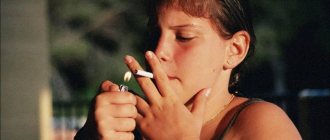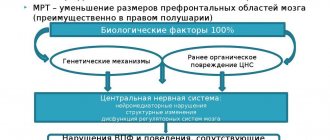Children's tantrums at 2 and 3 years old are a special behavior of a child that calls for attention. This behavior depends on various kinds of circumstances and the people around him. It is expressed in a sharp cry, movement of arms and legs, head banging and falling to the floor. The reason for this behavior is the child’s failure to accept refusal or disagreement with it. They tend to stop as soon as people stop paying attention to the artist.
Dr. Komarovsky associates children's tantrums at 2-3 years of age with crisis periods in the child's development. The condition occurs suddenly and, as a rule, the baby does not calm down immediately. How to prevent mental trauma with your attitude, which will develop from children's hysterics?
Komarovsky E.O. recommends highlighting those cases that will lead to hysterical behavior. It is not particularly difficult to identify the reasons for non-standard behavior. Being a reaction to certain phenomena, tantrums in a 2-3 year old child are still part of natural development.
If your child doesn't sleep well
When a child sleeps poorly, it becomes a problem not only for himself, but also for his parents and, most often, for the whole family. Sleep disorders are common in childhood and adolescence and are associated with neurocognitive and psychosocial impairment. Sleep problems in infants, children and adolescents manifest themselves in a variety of ways, often leading to significant impairment in daily functioning - from emotional and behavioral disturbances to cognitive decline, which can affect overall development.
While difficulty getting to sleep and frequent night awakenings tend to be more prevalent in infancy and early childhood, sleep difficulties due to poor sleep hygiene or circadian rhythm disturbances tend to be more pronounced during adolescence. If a child or teenager is not sleeping well, it can further complicate any underlying health conditions such as obesity and asthma, as well as psychological problems such as depression, anxiety and substance abuse.
Chronic sleep disturbance in children and adolescents can lead to problems with cognitive functions such as attention, learning and memory. Behavioral interventions for sleep problems in children (eg, parent education, positive bedtime routines), especially in young children, have been shown to result in clinically significant improvements. This is especially important given the undesirability of using drug therapy in uncomplicated cases of sleep disorders in children.
After the storm
Sometimes a child will have difficulty breaking out of a tantrum . In this case, it helps to tell him: “I will help you calm down.”
Be sure not to reward your child with weakening after temper tantrums. This will only show the child that the anger was effective. Instead , praise your child when he regains control.
Some children are especially vulnerable after a tantrum, usually when they know they were right. Now is the time to hug your child and make sure you love him no matter what.
What diseases can cause sleep disturbances in children?
Poor quality and/or quantity of sleep in children can be associated with a variety of problems, including academic, behavioral, developmental, social difficulties, weight problems and other health problems. A large number of medical conditions can also contribute to sleep disturbances in children, including:
- Emotional and behavioral disorders
- Snore
- Upper airway resistance syndrome
- Obstructive sleep apnea
- Central sleep apnea
- Restless legs syndrome
- Actually insomnia
- Sleep behavior/parasomnias at night
Specific sleep disorders in children and adolescents
Sleep disorders related to breathing
Breathing-related sleep disorders include habitual snoring, obstructive sleep apnea, upper airway resistance syndrome, and obstructive hypoventilation syndrome. In children and adolescents, concerns about symptoms (eg, snoring) that indicate an underlying breathing disorder, such as obstructive sleep apnea, require exploration of associated symptoms such as pauses in breathing, chronic morning headaches, dry mouth, nighttime bedwetting, morning thirst, feeling sluggish and tired upon waking, a history of chronic ear infections, recent weight gain, hyperextension of the neck during sleep, and chronic mouth breathing.
The main cause of breathing-related sleep disorders in children is adenotonsillar hypertrophy. If there are no signs of tonsil enlargement, other common causes include macroglossia (enlarged tongue), retrognathia (backward displacement of the jaw), high arched palate, and deviated nasal septum. Nasal polyps or posterior nasopharyngeal obstruction may also play a role. It is also important to note that children with disorders such as Down syndrome or Prader-Willi syndrome have craniofacial abnormalities, including midfacial hypoplasia or micrognathia, which predispose them to breathing problems leading to sleep disorders. Other risk factors include obesity, chronic sinus problems, and allergies.
Sleep disorders associated with movement disorders.
Sleep-related movement disorders in childhood include sleep myoclonus in infancy, rhythmic movement disorder, periodic limb movement disorder, and restless legs syndrome. Sleep myoclonus in infancy is usually associated with clusters of myoclonic jerks that affect the entire body, trunk, or extremities. They are generally considered benign and gradually disappear after six months of age without requiring further treatment.
With a rhythmic movement disorder, the child demonstrates repetitive and stereotypical motor behavior involving large muscle groups and mainly during sleep. This disorder can also lead to daytime mobility problems and physical injuries. The diagnosis can be definitively made after videopolysomnography. Treatment includes providing a safe sleeping environment for the child and reassuring parents that the disorder will resolve on its own by age 5.
Periodic limb movements during sleep are short twitches (movements) of the lower or upper limbs during sleep that can last up to five seconds periodically at intervals of 20-40 seconds.
Restless legs syndrome manifests itself as an urge to move the legs that begins or worsens while sitting or lying down, but resolves completely with movement. The urge to move is stronger in the evening or at night than during the day, or occurs only in the evening or at night. Typically, children under 2 years of age present with senestopathies, such as “spider crawling” or “tickling feet.”
Actually childhood insomnia
Insomnia in children is defined as repeated difficulties in the initiation, duration, maintenance or quality of sleep that occurs despite age-appropriate time and opportunity to sleep, resulting in daytime functional impairment for the child and/or family. Behavioral insomnia in childhood most often manifests as sleep refusal or resistance at bedtime, delayed sleep onset, and/or prolonged nighttime wakefulness requiring parental intervention. When sleep onset is disrupted, children have difficulty falling asleep on their own and associate falling asleep with certain circumstances, such as a certain place (sofa or bed of parents), the presence of a person (mother or grandmother) or certain actions (bottle feeding, rocking, watching TV). Thus, these circumstances are necessary for the child to fall asleep or continue to sleep after waking up in the middle of the night.
In another variant of insomnia, the child delays bedtime through multiple requests or refusals, while the parent has difficulty setting limits for the child that allow bedtime to be delayed. Sometimes both types of insomnia can occur at the same time.
Sleep disorders in children associated with mental disorders
Sleep problems can be caused by childhood mental disorders. For example, increased arousal in attention deficit hypermobility disorder (ADHD) is associated with delayed sleep onset and reduced sleep duration in children and adolescents. In addition, deficits in sensory integration, disruption of circadian rhythms, rebound effects of psychostimulants, and comorbid anxiety disorders contribute to insomnia in children with ADHD.
Subjective sleep complaints are common in children with major depressive disorder as well as anxiety disorders. There is a bidirectional relationship between sleep disturbances in children and affective states. In other words, a child's unstable emotional state can lead to persistent sleep problems, and chronic sleep deprivation can lead to behavioral and mood disorders.
Sleep disturbances in children with PTSD may include a variety of parasomnias, including nightmares, sleep enuresis, and severe insomnia. There are two types of post-traumatic stress disorder in children with distinct sleep disturbances: trauma, in which children experience a specific acute traumatic event leading to hyperarousal and associated insomnia, and trauma, in which children experience chronic traumatic stressors. Nightmares, a specific sleep disorder, are extremely common in children and adolescents suffering from traumatic events, such as sexual abuse or physical abuse, and are usually not treatable. The thematic content of nightmares in PTSD is related to previously experienced trauma.
Parasomnias
Parasomnia is defined as unwanted physical events or experiences that occur while falling asleep, while asleep, or during awakenings from sleep. They are classified as rapid eye movement (REM) parasomnias or non-REM parasomnias. Parasomnias without REM sleep (also called arousal disorders) are associated with simple or complex behavior as a consequence of arousal in the first half of the night. They are associated with confusion and amnesia for nightmares or events in the night. Agitation, nightmares, and sleepwalking (somnambulism) are considered part of a non-REM sleep parasomnia. Confusion usually occurs immediately after falling asleep or in the early morning and is associated with short-term confusion in the thought process after waking up. There appears to be an increased prevalence of these disorders in early childhood, which usually resolves by age 5 years.
Nightmares are associated with inconsolable crying (consolation usually only delays recovery from the incident) and increased activity of the autonomic system. Night terrors seem to go well in childhood. However, more severe forms of the disease may require behavioral interventions such as scheduled awakenings and treatment with benzodiazepines (eg, clonazepam).
Sleepwalking is usually associated with chronic sleep deprivation. Therefore, it is important to maintain adequate sleep hygiene to prevent such episodes. It is also important to note that certain conditions (such as Tourette's syndrome and migraines) are also associated with an increased prevalence of somnambulism.
Still have questions?
Get an online consultation from leading pediatricians in St. Petersburg!
A professional and experienced pediatrician will answer your questions.
Medical care for a child without leaving home at a convenient time.
sign up for a consultation
A Skype consultation lasts 45 minutes.
How are sleep disorders diagnosed in children?
To facilitate correct diagnosis, parents should be encouraged to record their children's sleep and wake patterns using sleep diaries over a 24-hour period for at least two continuous weeks before the first visit. This may be useful in confirming sleep-related complaints as well as in taking a thorough history. Sleep diaries also help identify day-to-day variations in sleep patterns that can often be missed by routine history taking. Graphic diaries are more useful for understanding children's sleep-wake cycles.
Parents can also complete the 26-item Sleep Disorders Questionnaire for Children (SDSC), which was developed for children and adolescents to screen for primary sleep disorders such as obstructive sleep apnea.
Medical evaluation of a child with sleep disorders includes calculation of body mass index (BMI) and waist circumference measurements are important because higher BMI and larger waist circumference are independent risk factors in predicting the severity of sleep disordered breathing, especially in older obese children. Equally important is measuring blood pressure. The physical examination may be focused (eg, examining the upper respiratory tract and nasal passages in a healthy, typically developmental child with parental complaints of snoring and excessive daytime sleepiness) or comprehensive (eg, in children with neuromuscular disorders and chronic illnesses). In addition to the physical examination, radiological studies such as a lateral X-ray of the neck (if adenoidal hypertrophy leading to obstructive sleep apnea is suspected) and laboratory studies such as serum iron and ferritin levels (if limb movements associated with sleep apnea are suspected) may be helpful. sleep).
Overnight polysomnography is recommended as the gold standard for diagnosing sleep-related breathing disorders, such as obstructive sleep apnea, in children and adolescents. However, polysomnography is not useful for diagnosing behavioral sleep disorders such as behavioral insomnia. Diagnostic tests such as the multiple sleep latency test (MSLT) can be useful for quantifying sleepiness and examining the presence of sleep disorders (eg, narcolepsy) that may predispose children and adolescents to daytime sleepiness.
Reasons that cause nervousness in babies:
- The presence of circumstances that provoke interference with the baby’s important affairs.
- The only way to attract adult attention.
- The child's needs are not fully met.
Of course, the main cause of hysteria is recognized to be the imperfection of the children's nervous system. The child does not know how to control the manifestations of his dissatisfaction, and the habit of adequately expressing dissatisfaction will appear much later. It should be understood that sudden crying does not indicate the presence of any disease. In most cases, children's tantrums for 2-3 years (Dr. Komarovsky) are not dangerous. But it is extremely unacceptable to leave the situation unattended.
Let's consider what methods are available to resolve the situation. Although, according to the famous doctor, it is best to prevent the symptoms of impending hysteria in advance and not bring the child to tears. How can this be done in practice?
What can parents do themselves if their child is not sleeping well?
| METHOD | Child's age | DESCRIPTION |
| Age-appropriate and consistent bedtimes and sleep patterns | All children | The child is put to bed in accordance with his age at the same bedtime consistently 7 days a week with minimal deviations. |
| Sleeping mode | All children | Sequence of actions half an hour before bedtime. The steps are performed the same way every night to “signal” the onset of sleep. No more than 30 minutes with 2-3 relaxing activities (bath, story) and ending in the bedroom. For young children or children with developmental delays, pictures are used to reinforce the sequence of actions. You can also check boxes and earn stickers for completing each step of the routine or completing the entire routine. |
| Indifference method | Young children | The child is placed in a bed or crib while he is still awake, then the parents are asked not to react to screams or protests. It is necessary to warn parents that the protests will first increase and then decrease. |
| Gradual indifference | Young children | The baby is placed in a bed or crib while still awake, then the parents leave the room and wait an increasing number of minutes before re-entering the room for a brief, neutral interaction with the baby. After each re-entry, the number of minutes until the next login gradually increases after each trial and over several days. |
| Also used to reduce the presence of parents to teach the child to fall asleep independently. Instead of leaving the room, the parent moves away from the child every few nights. In both cases, warn parents about the outburst of emotions that may occur during the first few nights. | ||
| Positive routine | Young children | Establish a bedtime routine that features positive and enjoyable parent-child interaction with one or two of the child's favorite activities. The parent constantly praises the child, but if the child refuses a step or has a tantrum, the routine ends, the child is put to bed, and communication ends. |
| Tiredness before bed | Small children, young children with late bedtimes | The baby is put to bed closer to the time he or she is most likely to fall asleep. After falling asleep within 15-20 minutes, bedtime is moved up 15 minutes every 2-3 nights until your desired bedtime is achieved. |
| Scheduled wake-ups | Young children | Determine your baseline pattern of awakenings using a sleep diary. 15 to 30 minutes before a typical nighttime awakening, as determined from a sleep diary, the parent pre-awakens the child by gently shaking him and asking him to wake up. When the child responds by slightly opening his eyes or babbling, the parent allows the child to go back to sleep or gives a "typical" response to soothe the child back to sleep (i.e., rocking, feeding, patting). The procedure is performed every night for 2–4 weeks. |
| Parental education | All children | Education regarding sleep hygiene measures, habits that promote good sleep, reducing caffeine intake, consistent and appropriate development of sleep and wake times. |
| Cognitive behavioral therapy | Children approximately 8 years of age and older | Methods include progressive muscle relaxation, deep breathing exercises, imagery, cognitive techniques to reduce negative thoughts before bed, or worry journaling, all of which can be used independently or together to reduce levels of arousal and anxiety before bed. Increased likelihood of falling asleep. |
Call a doctor at home Make an appointment with a doctor or call +7 (812) 331-17-74
Doctor's advice
The popular TV presenter believes that overcoming crisis situations directly depends on the ability of parents to communicate with their children. This presupposes flexibility in the behavior and actions of mothers and fathers, as well as grandparents.
Features of communication
The crisis in three-year-old children occurs differently. The main thing, as Komarovsky says, is to learn to get along with the child, yielding to him in small things, but not allowing himself to be manipulated.
Here's what the pediatrician advises:
- Always remain calm and consistent in your actions.
- Don't become a spectator of the hysteria being thrown. Give your child the opportunity to scream without your presence. Having lost the viewer, he will calm down faster.
- Do not let your child understand that he can achieve what he wants by shouting.
- Do not punish a child who is hysterical. Give him time to calm down. So he will understand that tears and heart-rending screams do not work.
- Do not get into an argument with your child, do not try to prove to him that you are right and do not force him to fulfill your demands. Let him cry, and when he calms down, try to come to an agreement with him, give in, if his desire does not contradict common sense and is safe for health.
- Stop overprotecting your child. Give him more independence.
- Showing sensitivity and patience, adhere to the same requirements and parenting tactics in the family.
- Avoid constant bans. However, NO, said by mom, should not be canceled by dad or grandma.
- Do not command your child, do not argue with him, trying to forcefully break his stubbornness. After all, the baby tests your patience and learns from you to defend his own point of view.
- Don't rush your baby while dressing and eating. He will do it slowly and not always correctly, but he will acquire the skills of independence.
- Look for a compromise, negotiate with the baby, giving him the right to choose. Prohibitions and punishments are not the best method of education. They deprive children of a positive desire to act and kill any initiative.
- Don't be shy about showing your feelings, hug and praise your baby. The baby should know that he is loved. Do not scold him for accidentally breaking a plate or a broken toy, because it is difficult for a child to distinguish between the attitude towards him and a bad deed. Just explain why it’s bad without yelling, without perpetuating his feelings of guilt.
- Does your child refuse to eat porridge? Play with him. You can offer to feed the doll, while instilling the rules of etiquette.
- Do not give bad assessments to the children’s actions, maintain confidence in him that he will succeed.
The correct tactics of communicating with a child during a crisis are the key to the child successfully overcoming it. Respect the developing personality in your baby, then behavioral deviations will pass without complications and quickly.
How to react correctly in critical moments?
Komarovsky's advice is simple. But in practice they show positive results in cases of hysterical attacks.
The pediatrician advises parents:
- Keep calm. Don't show your child that his behavior bothers you. Attempts to reason with the baby at this moment are doomed to failure. Let him calm down.
- Do not give up. Pity for a child during an emotional breakdown ends with the parents giving in to the child’s demands.
This is a direct path to frequent relapses. Children quickly learn that shouting can put pressure on their parents.
- Distract your baby. Switch his attention to a funny face or an unfamiliar object. This will help stop the hysteria.
- Caress the baby. But only on the condition that he does not refuse hugs and affectionate words.
- Do not punish him, especially with physical methods.
- Don't raise your voice a little. This will lead to an intensification of the attack.
You cannot follow the whims of the baby and change your opinion against the backdrop of his hysterics. When he calms down, you can calmly explain why his demand is impossible.











